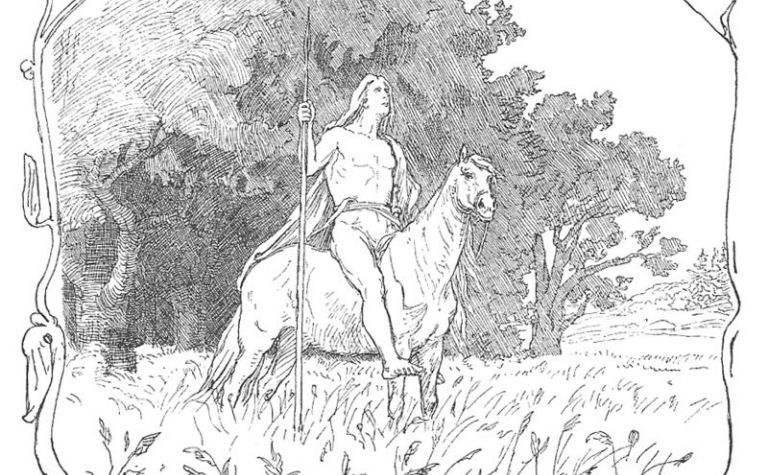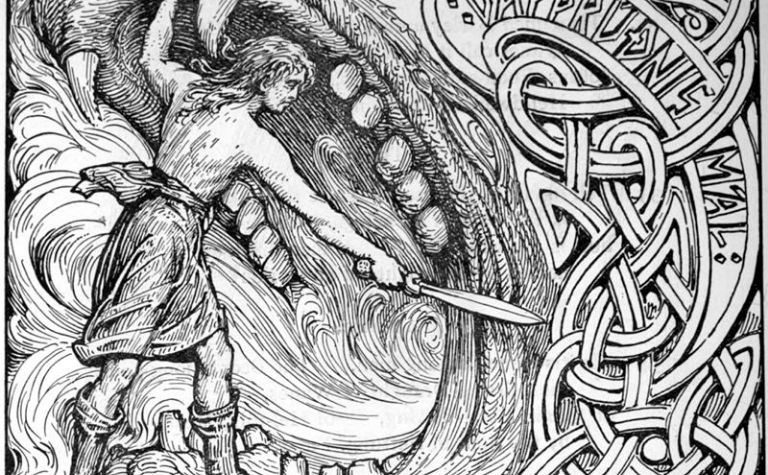Most people are familiar with some members of the Norse pantheon, like Thor, Odin, and Tyr. However, the catalog of Norse gods goes far beyond those three and includes many fascinating characters.
One such god is Vidar, sometimes known as the “silent god.”
Vidar is a son of Odin and the half-brother of Thor. He is an incredibly strong god who is prophesied to survive Ragnarok. He is also a fierce warrior who will defeat the giant wolf Fenrir, avenging his father’s death.
As with most figures from Norse mythology, not many stories about Vidar have endured to the present day.
Keep reading for a deep dive into the few surviving stories about Vidar and what we know about him and his role among the Norse gods.
Also, see Can Ragnorak Be Stopped? to learn more.

What Is Vidar Known For?
There are two main versions of the story of Ragnarok, or the death of the gods, which is the Viking’s story of the end of the world.
In one version, Ragnarok is the end of all things. But some stories say that it is a time of rebirth. Most gods, giants, and other creatures will die, but a few young gods and two humans will survive and rebuild a new world.
Vidar, the silent god, is best known for being one of the few gods to survive Ragnarok. He is also known for his strength and for being a god of vengeance.
This makes it all the more notable that he avenges Odin’s death by violently killing Loki’s son, Fenrir, the giant wolf.
Vidar is the child of Odin and the giantess Gridr.
Very little else about Vidar’s childhood or life before Ragnarok remains, but the myths do talk about his strength, which is second only to Thor’s, and his shoes, which he is constantly building up and making stronger for the day he will defeat Fenrir.
Vidar is associated with vengeance. Many prominent gods who die in Ragnarok die in the process of defeating an enemy.
Tyr and Garm, Thor and Jormungandr, Freyr and Surt, Heimdall and Loki–all of these pairs of gods and their foes die while killing each other.
Odin, on the other hand, does not kill Fenrir. Fenrir swallows Odin, and Odin dies.
In a vengeful rage, Vidar kills Fenrir. One account in the Poetic Edda claims that Vidar stabs his sword into the wolf’s heart. [1]
Another, the poem Vafthruthnismol, says that Vidar steps on Fenrir’s lower jaw with his powerful boot and rips apart Fenrir’s jaws with his hands.
This is the image more commonly associated with Vidar. Artists typically depict Vidar as holding open the giant wolf’s jaws with his sword in hand.
Also, see Fenrir: The Fascinating Wolf of Norse Mythology? to learn more.

Why Is Vidar Called the Silent God?
In several places in the Prose Edda, the historian Snorri calls Vidar “the silent god” or just “the Silent.” Vidar appears very little in written records, so it seems fitting that he is called silent.
But the source of this nickname is ultimately unknown.
Nobody knows for sure why Vidar is called the silent god. It may have something to do with his role as an avenger, or it could refer to how little is known about him.
The only story featuring Vidar is his battle with Fenrir in Ragnarok. Perhaps he is called “silent” because he does not speak at Ragnarok and simply avenges his father’s death.
Or maybe he is “silent” because he only has one recorded myth about him. He simply appears at Ragnarok to avenge Odin.
It is also possible the Vikings told other myths about Vidar, myths that featured him being silent, mysterious, or thoughtful.
Perhaps Vidar earned his nickname in these myths, but they did not survive to the present day.
Some scholars even believe that Vidar is “the silent god” because he takes his vengeance and does not boast or brag about it like the other gods would brag of their great deeds.
There are so few written records of Norse mythology that it is impossible to be certain.
Also see Norse Gods vs Greek Gods: Similarities and Differences to learn more.
What Powers and Abilities Does Vidar Have?
If Vidar has many special powers and abilities, they are not recorded in written sources. There is little evidence of his abilities beyond the descriptions of the events of Ragnarok.
Vidar has exceptional strength and is a talented swordsman. He also has a special leather shoe that allows him to hold open Fenrir’s jaws.
It is safe to assume that Vidar is quite strong, given his actions at Ragnarok.
Fenrir is a formidable foe, strong enough to kill Odin. Though Odin is not much of a fighter, he is considered the father of the gods, so Fenrir killing him is an incredible display of power.
Fenrir is also notable for maiming Tyr, the war god. And yet, Vidar kills Fenrir without getting hurt.
Still, it is Vidar’s leather shoe that sets him apart from other gods.
Snorri’s Prose Edda says that this shoe is made from scrap leather taken from mankind’s shoes. All the scraps of all the leather shoes in history come together to create this durable leather boot.
Vidar steps on Fenrir’s lower jaw with his special shoe, holding the giant mouth open. He grabs the wolf’s upper jaw and pulls Fenrir apart, killing him.
Vidar’s shoe is also called “the Iron shoe.” It is unclear if his shoe contains iron and leather or if the leather is tough enough to resemble iron.
Also, see The Valkyrie Symbol: What Does It Mean? to learn more.
Is Vidar Stronger Than Thor?
Vidar is demonstrably stronger than Fenrir, who kills Odin and maims Tyr. But how does he compare to Thor, the god strong enough to level mountains and drain the ocean?
Vidar is strong, but he is not stronger than Thor. The Prose Edda calls Vidar “nearly as strong as Thor,” and many scholars agree that Vidar is probably the second strongest of all the gods.
Thor is the strongest. He represented strength, virility, bravery, and perseverance to the Vikings.
It is unlikely that they would ever consider another god stronger than Thor, even though Thor dies in Ragnarok and Vidar doesn’t.
Thor dies after he strikes the killing blow to Jormungandr, the giant serpent surrounding the world (and, incidentally, Fenrir’s brother).
Thor kills Jormungandr with his hammer, but he is overwhelmed by the snake’s deadly venom. We have no way of knowing if Vidar could have done the same or if he could have survived Jormungandr’s venom.
After Thor’s death, Vidar might be the strongest of all the surviving gods. However, two of Thor’s sons also survive, and they have his magic hammer Mjolnir. Modi and Magni may be stronger than Vidar, at least with the help of their father’s weapon.
Because Vidar and Thor never fight each other, there is no way to determine who is stronger or better at combat.
The only evidence is that single quote from the Prose Edda, which states that Thor is stronger, but not by much.
Conclusion
Vidar is a symbol of vengeance and hope. He kills one of the fiercest monsters in Ragnarok and survives to rebuild the world afterward.
References:
[1] Source
